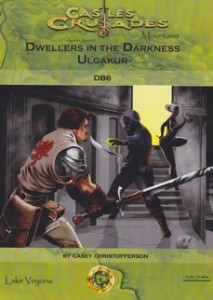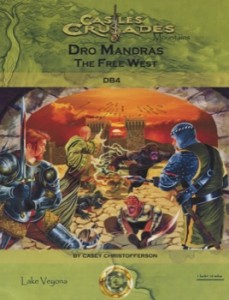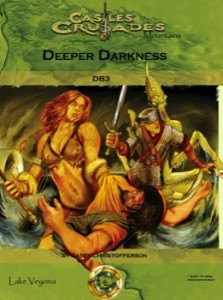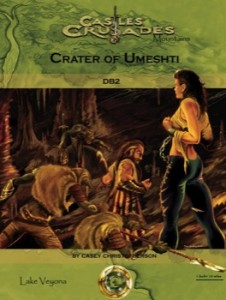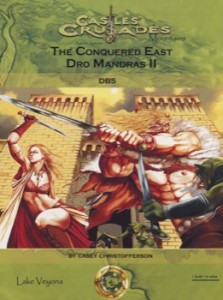
This is a Castles & Crusades adventure, although it can be used with an pre-4E version of D&D.
This may be a unique module. It provides for sandbox-like play in a city that is under siege. The players actions will influence which way the the siege goes. While rated for 4th level parties, it may be more fun at slightly higher levels. It’s going to take some homework by the DM to get the most out of it.
Dro Mandras is the capitol town of a certain Duchy, half on each side of a major river. The Duke gathered his forces and went out to subdue a group of neighboring kingdoms known as the Petty Princes, or Weakling Princes. While he was away there was a major humanoid uprising. They are ravaging his duchy and had broken through the walls of the eastern half of the city and were pillaging it when the Dukes army returned. Now both armies are racing north to beat each other to a nearby ford. Now the siege of the western shore, detailed in DB4 – The Free West, has slowed down while the boss is away … but progress continues in other ways.
The eastern map of the city has been divided up in to six or so sectors. Each sector has a number of buildings described, eight or so in general. Generally each sector is controlled by a different band of humanoids and their leaders with a couple of sectors having multiple bands in them. Each band has their own motivations, having been cajoled in to to joining the rampaging horde by the Big Bad, Yorgach. The various humanoid races tend to hate each other, and even hate other members of their own race that belong to a different tribe. The troops are held in check by their leaders, who generally have much bigger plans for the mass murder of their allies. In addition, each group has some sort of task they are in charge of for the continued siege of the city. Some man siege towers, others are sappers, and so on. There are large numbers of troops involved; I believe the most lightly defended sector has over a hundred while several have multiple hundreds of troops. Also on the eastern short is the last redoubt of a band of city defenders. They are hold up in a small walled off section of the eastern city. There the knights, paladins, dwarves, and other associated with the Adventuring Quarter are making a last stand and protecting a large group of refugees. They are under siege from the humanoids and many have vowed to fight to the last man.
Each section of the city has a number of objectives that the party could undertake to help lift the siege. Each has a point value associated with it, and when the point total reaches 400 then the infighting and loss of materials within the humanoid ranks will become so great that it’s possible for the cities defenders to take back their homes and lift the siege. While the various objectives are listed for the GM, no such list is going to be provided for the players. They will need to scope out the conquered eastern half of the city, find out what’s going on, and hopefully act like heroes and take actions they think will help lift the siege. And they need to do it in five days. In two days time the goblin sappers will have reached the walls of the last redoubt, and in three days more they will have collapsed the walls. Widespread slaughter will then ensue. The various objectives involve killing the leadership to provoke infighting, stopping the various sapping groups, discovering hidden magical artifacts, destroying siege equipment, and so on. This is going to be rough work. Many of the leaders are 8HD creatures, surrounded by groups of 4 HD creatures and then their masses of 1HD troops. Five days is not a lot of healing, and with most objectives being 20-40 points, the party is going to have their work cut out for them. There is some simple mass-combat advice given, which mostly works down to averaging large groups of opponents. This should help make some of the fights more manageable to run for the DM.
The various factions all had pretty interesting write-ups; I found them interesting, if a bit standard trope. Beyond the various objectives there are some areas with other little sub-plots, like the thieves guild hideout, mages and so on. There’s a fair number of non-standard encounters which tend toward the creative: zombie hands, staff of power breakages, holy sites that bless characters and so on. I really enjoy those sorts of things, it keeps the players on their toes. There’s a small dungeon provided in order to recover some holy relics to aid the last redoubt. It’s a ‘prove your worth’ type affair. I generally don’t like those, and I didn’t like this one. Lot’s of riddles and so on, which, at the levels suggested, has a significant possibility of frustrating players. I’m not looking for a cakewalk when it comes to puzzles, but relying on players to ‘Get It’ is not a worthwhile endeavor, in my experience.
If the party can get in to this section of the city and figure out how to move around mostly unseen then they should have a rollicking good time. A city under siege is a fantastic place to have a little sandbox type play. There’s a lot that the players can do: scheming, plotting, simple slaughter, clever plots, and so on. If I were to run this then I’d probably stretch the timeline out a bit more. Five days is just not enough time to fully experience what this place holds, hatch some plots, and see them through, not with rest & spell recovery to worry about. Alternatively, hooking the party up with some magic that accelerates healing and some rules for regaining spells from partial rest would really put the screws to the PC’s. “How long are you going to rest? A full night and you get a fireball back, but maybe all we need is a sleep or two to take out those siege towers, and that’s only 3 hours of rest.” This could be a nice little partisans campaign play area, with the party making supply drops, performing rescues, sabotaging equipment, spying, and getting in to all sorts of trouble. The major trouble area is going to be communicating and visiting the defenders in the last redoubt and with the free western side of the city. Figuring out how to run integrate those areas, in either a 5-day game or a longer game, will probably be the key to a successful game for the DM. Some kind of order of battle for each are would have been nice to see. I would probably also blow up the map and make a lot more notations on it, especially regarding troop strengths. Many of the humanoids have horns to call for help, and quickly knowing who’s nearby to provide support, or who’s territory the party is fleeing in to, will be important. Maybe something like those one-page adventures that are popular in certain circles.
Several of the Castles & Crusades modules have explored areas not traditionally covered. They’ve done a good job with this product in providing a locale and sandbox-like play in an area that is not often covered. Good city based games are the definition of sandbox play, while sieges and hordes are not something that is traditionally covered. The writing is a little flat at times, and the DM is going to have to do some homework, however it’s a very interesting product and unlike any I’ve seen before.
This is available on DriveThru.
https://www.drivethrurpg.com/product/60992/Castles–Crusades-DB5-The-Conquered-East?affiliate_id=1892600

